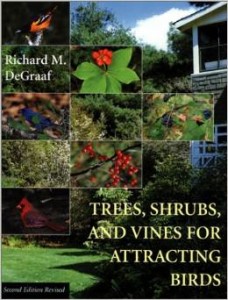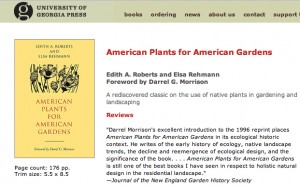Two Books and a Seminar: Musings on the State of the Landscape Profession
March 28, 2015 by admin
Filed under Book Reviews, In the News
Every now and then it’s good to stop and reflect on why and how you do what you do, and recently I had a couple of opportunities to examine the current state of my own motivation and thoughts on a few aspects of landscape design.
First, I had the honor of being the subject of a small business profile in Turf Design Build magazine. Answering the questions they asked proved to be an interesting exercise.
The audience for Turf Design Build is a professional one, so they asked me about business challenges as a member of the green industry as well as long-term goals, sources of inspiration, how and why certain landscapes give me special enjoyment, and more. I took the chance to share a few ideas that have occupied me in recent years, including the ecological impact of gardening and the importance of context for landscaping choices. I hope you’ll take a moment to follow the link and read it.
They also asked me to identify favorite landscape design books. There are many I could have named, but I wanted especially to mention ones I felt were truly educational with a long shelf life as reference books. First, the works of Richard DeGraaf, a Massachusetts-based wildlife biologist (and not just because his publisher is my own publisher, the University Press of New England). His Trees, Shrubs & Vines for Attracting Birds is a beautiful book just chock full of practical information for gardeners who are trying to build more bird-friendly habitats. I also encourage gardeners to read his books on wildlife since plant life and wildlife are so intimately connected.
The second recommendation was what I called “an obscure little book” called American Plants for American Gardens. Written in the 1920s for an audience in the Hudson Valley of New York (but inexplicably reprinted in 1996 by the University of Georgia Press, to which I am very grateful), it was one of the first gardening books (perhaps the first?) to take an ecological approach. It was quite remarkable for its time, and in many ways decades ahead of its time. It’s still available for purchase, and those of you who would like to examine it before buying may be able to get it from a local library. (I can see online that a handful of copies are available through the Connecticut interlibrary loan system.)
Given the fact that I don’t think a lot of people are aware of this little gem, imagine my surprise when, a few weeks ago, I attended a seminar led by Larry Weaner of Larry Weaner Landscape Associates and in the course of his presentation he mentioned and recommended…American Plants for American Gardens!
Weaner’s name has come to be associated with meadows, but that’s much too narrow a slot to put him in. His work attempts to reconcile the needs and desires of people with the needs and floral/faunal “trajectory” (as he would say) of the land they live on. I have been moving in the same direction for many years myself, and it was an education to see examples of projects in which he’s tried to implement practical landscape designs based on ideas that resonate with my own. I strongly encourage every gardener in the Northeast to hear Larry speak if the opportunity arises, and go with an open mind about what the goal of a landscape should be.
I expressed similar sentiments (or attempted to, at least) in my answers to the questions Turf Design Build asked me, although in a much shorter format. I’m so pleased and encouraged to find that ecology as a vital aspect of landscape design finally seems to be gaining traction both in the mind of the gardening public and on the drawing tables of the landscape profession. I hope this trend continues to gain momentum, and if it’s new to you, that you’ll explore and find value in it as you make your own landscaping choices.




